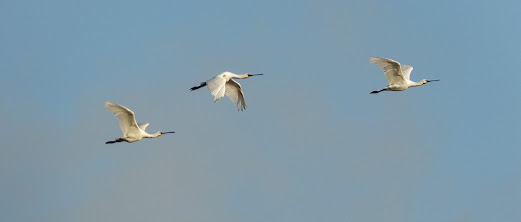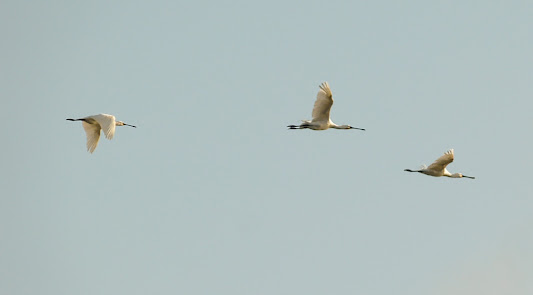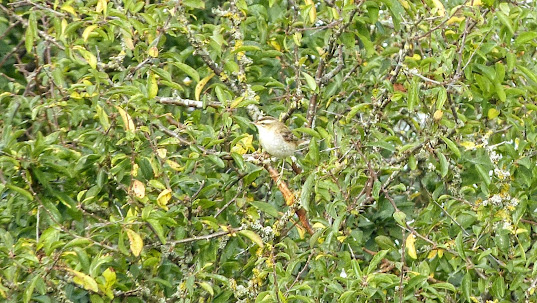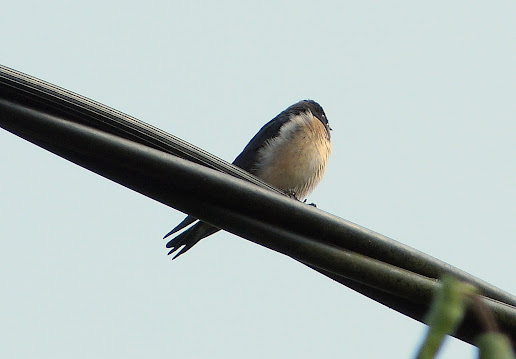Monday 26th August 2024.
One of the marvelous views overlooking Pennington Marshes looking east.
I took the opportunity on this Bank Holiday Monday to take a trip down to Pennington & Keyhaven Marshes with both Matt & Emma Parkes today and we had a great variety of birds on this superb reserve. Not only did we get a hatful of lovely birds to look at, including a ‘year-tick’ for me here; we later went into the New Forest to take a look around Pig Bush area and again, there was a nice variety of birds here to look at. The weather simply couldn't make its mind up today, although the majority of the day, it was bright and sunny with a breezy south-westerly. We finished the day off searching for a Pied Flycatcher that was reported around the Church at Nursling.
Above, the three Spoonbills that were on Fishtail Lagoon eventually landed on Butts Lagoon.
My day started by meeting the guys at Fareham Leisure Centre car park, but getting there was a bit hairy to say the least. A huge downpour over the M27 made the motorway like a lake and my car did not like it one bit. Thankfully, I did take my wet weather coat along with me, but as soon as I got to the car park, the rain had totally stopped. Phew! While waiting for them to arrive, I heard a variety of birds calling in the distance that included a Yellow Wagtail, Jay, Goldcrest and a variety of finches and titmice all calling in the background. It probably was worth going to give the area a good once over, but I didn't have the time.
Above and below, good numbers of Redshank were offshore by the mudflats and islands.
Above, a juvenile Sparrowhawk was hunting over the saltmarsh and then flew northbound close to where we stood. Below, summer plumage Grey Plover were on the mudflats offshore.

On arrival within the car park at Pennington Marshes, we walked south to the sea wall and took a lazy stroll westbound along the seawall. The tide was out within the Solent, exposing a lot of the mudflats that supported a variety of waders that included Ringed Plover, Oystercatcher, Curlew and Turnstone plus a few Dunlin; but on the first stretch of water on Fishtail Lagoon, there was a selection of waders here included around 60+ Black-tailed Godwit, 2 Common Sandpipers, several Lapwing and a lone Common Snipe. Three adult Spoonbills could be seen in the distance and after a short while, the Spoonbills took off and flew eastbound right in front of us. Gorgeous. A pair of Reed Buntings flew up from the seawall and headed off onto the reserve and Pied Wagtails seemed to be everywhere. I was hoping for a Little Stint or Curlew Sandpiper, but despite a good search, there was no sign of them here today.

Above, one of two Common Sandpipers (centre) on Fishtail Lagoon among Black-tailed Godwit. Below, a Common Snipe feeding in the same area.
Above, a lone Black-tailed Godwit flying across the lagoon and below, a large contingent of Black-tailed Godwits sharing an island with Canada Geese.

Out in the Solent, we picked up some of the distant Eider ducks swimming on the water and some on the islands, while back on dry land, both a female Marsh Harrier and a Kestrel were seen. Matt soon picked up a juvenile Sparrowhawk hunting over the islands and it quickly settled on the saltmarsh for a few minutes before flying towards us and then northbound over the reserve, scattering some of the waders and a large number of Pied Wagtails. Both Grey and Yellow Wagtails were heard, but sadly, no sightings of the birds. Things got even better regarding the raptors when I found a juvenile Osprey fishing over the Solent. I then watched the bird fly down and plunged into the sea to grab a fish. It wasn't successful this time, but as we watched it hovering over the sea again, it splashed down again and this time, it was successful and then flew off to find a perch (which it did) to eat its breakfast. I might be an old Birder now and have been birding for over 46 years; but that was the first time ever I have actually seen an Osprey hunting and be successful. Simply amazing to watch.

Above and below, having been successful in catching a large fish, the juvenile Osprey began its breakfast. Emma picked out a blue ring on one of the legs and looked good for one of the Poole Harbour birds.
Above, a Grey Heron coming into land by Fishtail Lagoon and below, a Willow Warbler in the large clump of bushes between the two Lagoons.
Above, a Reed Warbler showed well at times in the large clump of bushes and below, a Sedge Warbler popped out too.
Above, the female Stonechat sat nicely on the fence below the seawall and below, one of two Wheatears were also seen from the seawall.

Between both Fishtail and Keyhaven Lagoons, there is a large clump of trees and bushes and this excellent spot supported a good variety of passerine species here that included Reed and Sedge Warbler, Cetti’s Warbler, Willow Warbler, Lesser and Common Whitethroat, Greenfinch and several Robins! Nearby, we found a pair of Stonechats on the sea wall and at least two Wheatears were picked up perched on the Gorse Bushes. This variety of birds kept us entertained for a good twenty minutes or so as we soon made our way to the Jetty Lagoon where a Wood Sandpiper was reported. The Spoonbills seen earlier, were now sleeping quietly on Butts Lagoon as we passed and to be honest, we were going to walk past the Jetty Lagoon when Matt stopped to check out an interesting wader that had caught his eye. It turned out to be a Spotted Redshank in winter plumage feeding on the far side of the pool and better still, Emma saw a smaller wader nearby; the Wood Sandpiper. This was my first ‘Wood Sand’ of the year and the bird looked stunning in the sunshine. Just a shame it was so far away as my photos didn't do it justice. We managed to get a few other birders onto these exciting waders (my good deed for the day!) and after checking the Solent once more where we saw a few more Eiders out on the water and a pair of Great Crested Grebes; we then decided to take a trip to Pig Bush, within the New Forest. As we made our way back to the car, there was a large flock of Goldfinches present, fluttering around the fields and hedgerows and some feeding on the Teasel and overhead, Swallows and Sand Martins chased insects in the sunshine.

Above, Hurst Castle and Lighthouse in the distance and the Isle of Wight behind it. I must pay a visit here one day. Below, a flock of Ringed Plovers were present just off the seawall.
Above, both the Wood Sandpiper (left) and Spotted Redshank remained distant on the Jetty Lagoon. Below, the Spotted Redshank did venture out a bit closer.
Above, a showy Grey Heron on Jetty Lagoon. Below, Emma checking out the birds offshore. I think, if you can put up with the many Cyclists, joggers and dog walkers; then this has to be one of the best nature reserves in Hampshire.
The car park at Pig Bush was quite busy as we parked up and then took a stroll around the edge of the wood, southbound. It didn't take long to get onto a group of Spotted Flycatchers busying themselves chasing insects. In all, it was difficult to get an exact count as they were very flighty, but at least 7+ were here including several juveniles. A Firecrest was heard and eventually seen very well several times as was a few Treecreepers. A couple of Marsh Tits were showing well for us too as they flew from bush to tree to bush in search of food. Fellow Birder (and ‘Lazee’) Steve Laycock and his friend joined us for a chat for around ten minutes as we watched the Flycatchers go about their business.
Above, some of the Spotted Flycatchers at Pig Bush this afternoon. Below, my first Heath Bumblebee of the year.
Above, a Hornet-mimic Hoverfly took us by surprise. I have not seen many of these away from Highland Road Cemetery. Below, Emma found some Puffball toadstools.
Above, at least two Treecreepers were seen in the woodland at Pig Bush.
After Steve left to go to Keyhaven, we carried on with our walk and enjoyed more views of the Spotted Flycatchers; but we could not find any Pied Flycatchers here, unfortunately. On the heath, I could hear a family flock of Linnets and some landed on the same bush as a male Stonechat. A Heath Bumblebee, my first of the year, was found walking on the ground and all around, I could hear the sound of Wood Crickets stridulating deep within cover; though they seemed to be everywhere. A Hornet-mimic Hoverfly briefly settled on a bramble and Matt even found a Froglet that quickly hopped into cover and out of view. We then walked south along the heath and entered another wood where we had good views of another Treecreeper and a pair of Stock Doves; though it was very quiet there. A Great Spotted Woodpecker flew over our heads after having seen it perched high up in a distant dead tree. Sadly, there were no Honey Buzzards on show, even though Steve Laycock had seen one earlier as well as a Goshawk.

Above, a distant Red Kite soared over woodland and fields behind St. Boniface Church.
Above and below, these juvenile Swallows were being fed by the parents that were hunting nearby.
After having lunch back at the car park, Emma had seen a post on Going Birding that a Pied Flycatcher had been seen at a church in Nursling, near Southampton and so we headed off there to round off the day. Sadly, even though we checked the churchyard here thoroughly, there was no sign and we realised that we were looking in the wrong place; but not before we had a sighting of a Red Kite and good numbers of Swallows. In fact, I think we were a long way off and so called it a day. I was knackered anyway, especially after getting a crap night's sleep and getting up so early; but it was most certainly a good day with some amazing birds and great company too. Below, is some of Emma's photos she took today.
Above, one of the Spotted Flycatchers at Pig Bush. Below, one of the Wheatear's at Keyhaven Marshes.
Above, a Marsh Tit at Pig Bush and below, the adult Swallow came in to feed its youngster.




























































